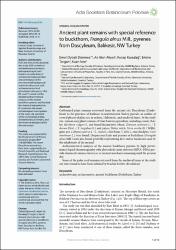| dc.contributor.author | Dönmez, Emel Oybak | |
| dc.contributor.author | Akyol, Ali Akın | |
| dc.contributor.author | Karadağ, Recep | |
| dc.contributor.author | Torgan, Emine | |
| dc.contributor.author | İren, Kaan | |
| dc.date.accessioned | 2020-11-20T14:55:07Z | |
| dc.date.available | 2020-11-20T14:55:07Z | |
| dc.date.issued | 2017 | |
| dc.identifier.issn | 0001-6977 | |
| dc.identifier.issn | 2083-9480 | |
| dc.identifier.uri | https://doi.org/10.5586/asbp.3520 | |
| dc.identifier.uri | https://hdl.handle.net/20.500.12809/2206 | |
| dc.description | WOS: 000396998000002 | en_US |
| dc.description.abstract | Carbonized plant remains recovered from the ancient city Dascyleum (Daskyleion) in the province of Balikesir in northwestern Turkey provide an outline of several phases of plant use in archaic, Hellenistic, and medieval times. At the study site, various crop plant remains of Near Eastern agriculture, including cereals (barley, Hordeum vulgare L. and bread/durum/rivet wheat, Triticum aestivum L. / T. durum Desf. / T. turgidum L.) and pulses [bitter vetch, Vicia ervilia (L.) Willd.; grass pea, Lathyrus sativus L. / L. cicera L.; fava bean, V. faba L.; and chickpea, Cicer arietinum L.] were found. Drupaceous fruits and pyrenes of buckthorn (Frangula alnus Mill.) were also found, probably representing dyes and/or medicines used by the inhabitants of the mound. Archaeometrical analyses of the ancient buckthorn pyrenes by high performance liquid chromatography with photodiode array detector (HPLC-PDA) provide chemical evidence for traces of ancient mordants remaining until the present day. Some of the pulse seed remains retrieved from the medieval layers at the study site were found to have been infested by bruchid beetles (Bruchidae). | en_US |
| dc.description.sponsorship | Research Unit of Ankara UniversityAnkara University [BAP 11B 6055003]; Turkish Scientific and Technical Research CouncilTurkiye Bilimsel ve Teknolojik Arastirma Kurumu (TUBITAK) [109 K 363]; Turkish Historical Society; Turkish Culture and Tourism Ministry | en_US |
| dc.description.sponsorship | This study was supported by the Research Unit of Ankara University (project BAP 11B 6055003). The recent Dascyleum excavations have been supported by the Turkish Scientific and Technical Research Council (project No. 109 K 363), Turkish Historical Society, and Turkish Culture and Tourism Ministry. | en_US |
| dc.item-language.iso | eng | en_US |
| dc.publisher | Polskie Towarzystwo Botaniczne | en_US |
| dc.item-rights | info:eu-repo/semantics/openAccess | en_US |
| dc.subject | Archaeobotany | en_US |
| dc.subject | Archaeometry | en_US |
| dc.subject | Ancient Buckthorn | en_US |
| dc.subject | Daskyleion | en_US |
| dc.subject | Turkey | en_US |
| dc.title | Ancient plant remains with special reference to buckthorn, Frangula alnus Mill., pyrenes from Dascyleum, Balikesir, NW Turkey | en_US |
| dc.item-type | article | en_US |
| dc.contributor.department | MÜ, Edebiyat Fakültesi, Arkeoloji Bölümü | en_US |
| dc.contributor.authorID | 0000-0002-9053-8693 | |
| dc.contributor.institutionauthor | İren, Kaan | |
| dc.identifier.doi | 10.5586/asbp.3520 | |
| dc.identifier.volume | 86 | en_US |
| dc.identifier.issue | 1 | en_US |
| dc.relation.journal | Acta Societatis Botanicorum Poloniae | en_US |
| dc.relation.publicationcategory | Makale - Uluslararası Hakemli Dergi - Kurum Öğretim Elemanı | en_US |


















